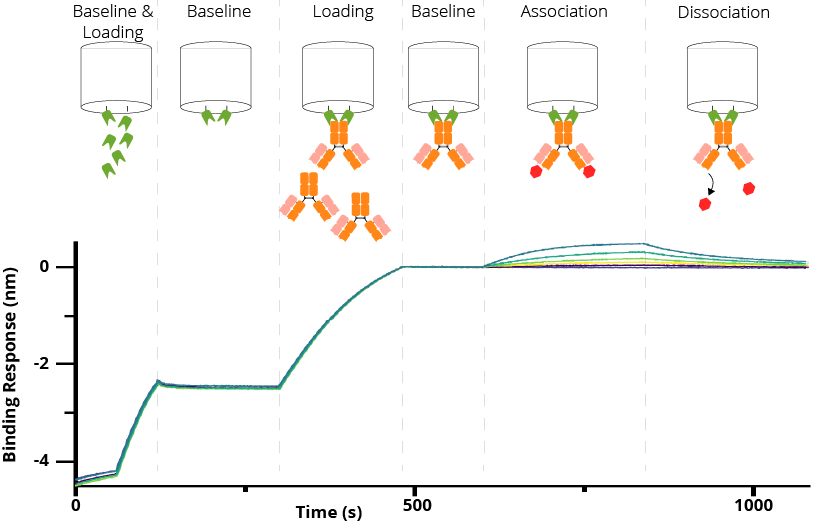Characterization of COVID-19 antibodies by Bio-Layer Interferometry using Nano-CaptureLigands
Binding of the immobilized COVID-19 antibodies to their target, the receptor-binding domain (RBD) of the SARS-CoV2 Spike protein, is characterized with regards to ka, kd, and KD.
Characterization of antibodies
Essential aspects of how antibodies (Abs) bind to their targets are their affinity and binding kinetics. In order to determine these parameters, different biophysical methods such as Surface Plasmon Resonance (SPR), Bio-Layer Interferometry (BLI), MicroScale Thermophoresis (MST), or Enzyme-linked Immunosorbent Assay (ELISA) can be applied. Some of these methods require the immobilization of the antibody on a surface and the titration of the target antigen to measure the dissociation constant KD and the association and dissociation rates ka and kd (also called on- and off rates kon and koff).
The appropriate immobilization of the Ab is crucial for the accurate determination of affinity and kinetics. Particularly, it is important that the antibody is immobilized in a site-directed manner to ensure that its paratope is accessible. Additionally, the antibody should be immobilized in a way that it’s still natively folded to ensure binding. Finally, the immobilization should be stable to avoid antibody dissociation from the surface during the measurement. In summary, a gentle, stable, site-directed method without modification of the antibody is needed.
In this blog post, we show how antibodies, here recombinant and chimeric COVID-19 antibodies, can be immobilized using Nano-CaptureLigands™ on streptavidin surfaces without further modification. Binding of the immobilized COVID-19 antibodies to their target, the receptor-binding domain (RBD) of the SARS-CoV2 Spike protein, is characterized with regards to ka, kd, and KD.
What are Nano-CaptureLigands and how do they work?
ChromoTek's Nano-CaptureLigands are capture reagents for the site-directed, gentle, and homogenous immobilization of antibodies in biosensor assays like BLI. Nano-CaptureLigands are biotinylated VHHs, also known as Nanobodies. They capture non-biotinylated antibodies with high specificity for their immobilization to streptavidin/avidin coated surfaces.
Due to their advanced immobilization of antibodies, Nano-CaptureLigands provide a stable baseline with negligible antibody dissociation and can be frequently regenerated for multiple reuse. Furthermore, they enable the selective immobilization of antibodies from crude liquids such as hybridoma supernatant, serum, and plasma samples.
Nano-CaptureLigand scan be used for BLI, SPR and ELISA assays and are available for the capture of:

BLI binding kinetics of human antibody CR3022 to SARS-CoV2 Spike RBD.
For details see the application note below.
Application note summary
The application note “Nano-CaptureLigands for COVID-19 antibodies capture in BLI binding kinetics assay” demonstrates that Nano-CaptureLigands are highly performing capturing tools for the functional antibody characterization via BLI. The binding kinetics of human and mouse variants of the COVID-19 antibody CR3022 to the SARS-CoV2 Spike receptor binding domain (RBD) have been determined. Obtained data agree very well with published data. The binding kinetics were determined using recombinant antibody versions with different Fc domains. Despite the differences, the results were identical, demonstrating the reliability of this new type of capture reagents.
Related Content
Scientists unravel why Omicron spreads faster
Neuropilin-1 joins ACE2 as SARS-CoV-2 gateway
How Nanobodies could advance Sars-CoV diagnostics
Neutralizing antibodies and their role in COVID-19 research
How fluorescent proteins can be applied in SARS-CoV-2 research
Serious about Serology: Understanding COVID19 Antibody Tests

Support
Newsletter Signup
Stay up-to-date with our latest news and events. New to Proteintech? Get 10% off your first order when you sign up.